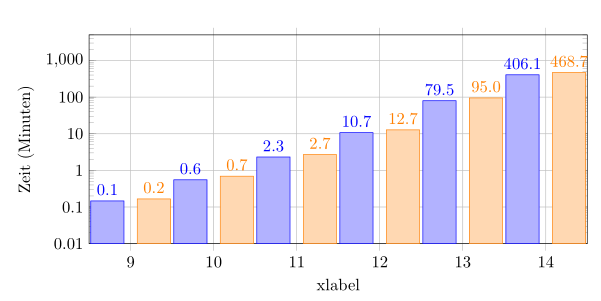Ich habe folgende Aufgabenstellung.
Ich habe ein Diagramm, dass mit einer logarithmischen Y-Skala besser zu erkennen ist.
Jedoch haben meine Kollegen gemeint ich sollte statt der logarithmischen Werte wie zB 10^2 etc. lieber den normalen Wert hinschreiben.
Im angehängten Bild sieht man wie es jetzt aussieht (jetzt.png).
und ziel.png zeigt was ich haben will.
Habe in der doku nichts gefunden, womit ich zwar die Werte logarithmieren kann, jedoch die Skala mit den richtigen (normalen) Werte anzeigen kann.
Ist das möglich?
\documentclass[10pt,a4paper]{article}
\usepackage[latin1]{inputenc}
\usepackage{pgfplots}
\pgfplotsset{width=\textwidth,height=6cm,compat=1.9}
\pgfplotsset{/pgf/number format/read comma as period}
\begin{filecontents}{test.dat}
XOR UN UO
9 0,1464 0,1658
10 0,5522 0,6937
11 2,3192 2,6957
12 10,6797 12,7331
13 79,5394 94,9720
14 406,1020 468,6611
\end{filecontents}
\begin{document}
\pgfplotstableread{test.dat}{\test}
\begin{tikzpicture}
\begin{axis}[
ybar=8pt,
bar width=20pt,
xlabel=xlabel,
ylabel=Zeit (Minuten),
grid=major,
ymode = log,
log origin=infty,
xtick=data,
minor y tick num=2,
xmin=8.5, xmax=14.5,
ymin=0, ymax=533,
every node near coord/.append style={
/pgf/number format/fixed zerofill,
/pgf/number format/precision=2
}
]
\addplot[blue,fill=blue!30,nodes near coords] table[x=XOR,y=UN] {\test};
\addplot+[orange,fill=orange!30,nodes near coords,ybar] table[x=XOR,y=UO] {\test};
\end{axis}
\end{tikzpicture}
\end{document}

